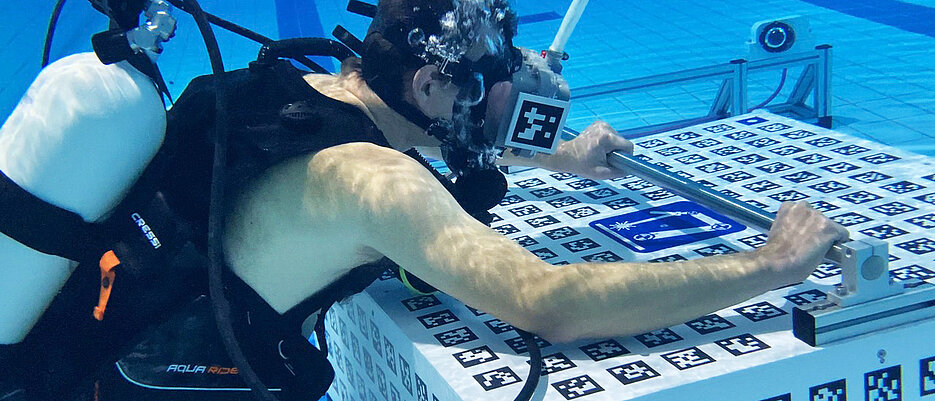Würzburg computer scientists dive down
01/12/2024Researchers at the University of Würzburg have developed a virtual reality (VR) application for training astronauts. It allows the training of various mission scenarios under water.

Nowhere can the zero gravity of space be simulated as well as in water - training in large indoor swimming pools is therefore part of the daily routine for astronauts in training. They practice repairs, replacing sensors and other operations over and over again in huge, elaborately prepared pools of water. At present, there are still often replicas of space stations, shuttles and capsules in these tanks on which they can practice.
However, a team of researchers at the University of Würzburg (JMU) has now developed a virtual reality (VR) application that could make space training more flexible and resource-efficient. The Chair of Computer Science XVII (Robotics) headed by Andreas Nüchter and the Chair of Computer Science IX (Human Computer Interaction) headed by Marc Latoschik were involved in the project.
Taking a look into space under water
"We believe that we can reduce the need for huge swimming pools for astronaut training with an innovative VR application," explains Andreas Nüchter. "By simulating space equipment in virtual reality, we eliminate the need for large swimming pools and elaborate replicas." In a study funded by the European Space Agency (ESA), the Würzburg team combined diving goggles with a VR headset to simulate a realistic space environment.
Astronauts use the headset to immerse themselves in a virtual space. They see a digital image of the space station in front of them. Underwater tracking systems enable them to position themselves precisely and orientate themselves in space, allowing them to move around the virtual station and change their perspective.
You can watch a video of the new VR application here
Practical test planned at the European Space Agency in May
Making the headset waterproof was the biggest challenge for the Würzburg researchers. "3D printers can be used to print almost any shape, but the print results have to be waterproof," says Nüchter. It was also difficult to create the connection to the masks with different materials specified by the ESA. We also further developed our tracking so that the refraction of the camera rays in the water is correctly and precisely taken into account."
After the system was presented at the AR/VR conference of the European Space Agency (ESA) in December, an initial test is scheduled for May at the ESA Astronaut Centre in Cologne. The next development step that the Würzburg team is planning is the tracking of hands and tools.
Contact
Prof. Dr Andreas Nüchter, Head of the Department of Computer Science XVII (Robotics), Dean of Studies at the Faculty of Mathematics and Computer Science, Tel.: +49 931 31-88790, andreas.nuechter@uni-wuerzburg.de






